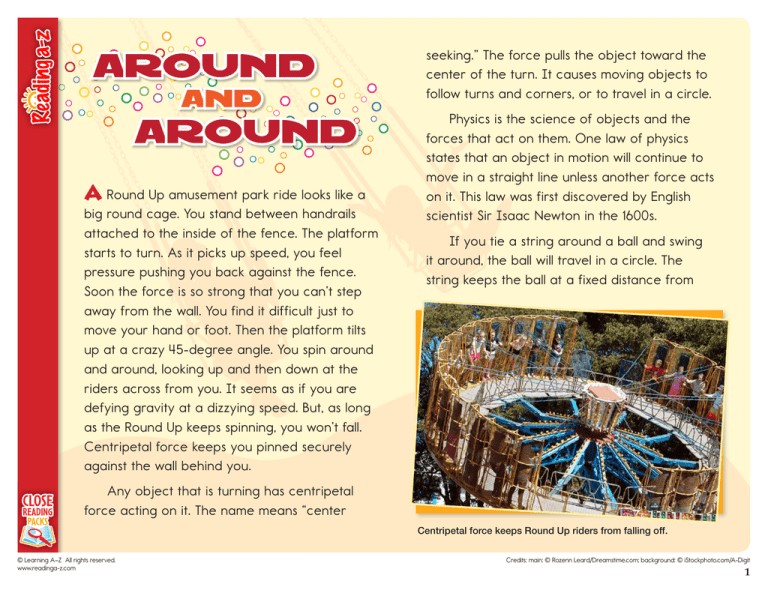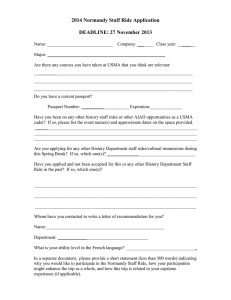
seeking.” The force pulls the object toward the
center of the turn. It causes moving objects to
follow turns and corners, or to travel in a circle.
A Round Up amusement park ride looks like a
big round cage. You stand between handrails
attached to the inside of the fence. The platform
starts to turn. As it picks up speed, you feel
pressure pushing you back against the fence.
Soon the force is so strong that you can’t step
away from the wall. You find it difficult just to
move your hand or foot. Then the platform tilts
up at a crazy 45-degree angle. You spin around
and around, looking up and then down at the
riders across from you. It seems as if you are
defying gravity at a dizzying speed. But, as long
as the Round Up keeps spinning, you won’t fall.
Centripetal force keeps you pinned securely
against the wall behind you.
Physics is the science of objects and the
forces that act on them. One law of physics
states that an object in motion will continue to
move in a straight line unless another force acts
on it. This law was first discovered by English
scientist Sir Isaac Newton in the 1600s.
If you tie a string around a ball and swing
it around, the ball will travel in a circle. The
string keeps the ball at a fixed distance from
Any object that is turning has centripetal
force acting on it. The name means “center
Centripetal force keeps Round Up riders from falling off.
© Learning A–Z All rights reserved.
www.readinga-z.com
Credits: main: © Rozenn Leard/Dreamstime.com; background: © iStockphoto.com/A-Digit
1
the center (your hand). You can feel the pull of
centripetal force along the string. If you let go of
the string, the centripetal force will disappear and
the ball will shoot off in a straight line.
Think about a satellite traveling around Earth.
It is launched straight up from the ground. Why
doesn’t it just keep going and fly off into space?
Its direction is changed by the force of gravity.
The centripetal force of gravity pulls it into orbit.
The designers of some of the most exciting
amusement park rides have made good
use of their
understanding of
the laws of physics.
Centripetal force
flattens riders of a
Gravitron against
DID YOU
KNOW?
Sir Isaac Newton
(1642-1727) is known for
his laws describing the
relationship between
forces and motion.
© Learning A–Z All rights reserved.
www.readinga-z.com
the inside wall as it spins. Suddenly the floor drops
out from under them. They stay stuck in place in
the middle of the wall! As a swing ride picks up
speed, the chairs spread nearly straight out from
the central column. Centripetal forces pull along
the chains and hold the seats at a set distance.
Believe it or not, centripetal forces keep roller
coaster cars on their tracks! Of course, the cars
are not attached to chains. The curves of the
tracks create centripetal forces that push against
the cars. That’s how the cars stick close to the
track around all those wild corners and curves!
Credits: left: © Photo Researchers/Alamy; right: © iStockphoto.com/Sergey Ivanov
2
its screaming passengers go back and forth
again and again. It tips up one way, swings back,
and then tips the other. Like the pendulum and
the playground swing, each pass doesn’t go
quite as high as the one before it.
What do a pendulum, a playground swing, and
a pirate ship ride have in common?
More than 300 years ago, an English scientist
made an important discovery. Sir Isaac Newton
was studying force and motion. He noticed that
a moving object kept moving unless some force
A pendulum is a weight hanging freely from
a fixed point overhead. If you set the weight
swinging, it will go back and forth for some time
before it runs down.
A swing is a large pendulum that works
the same way. After you
have pumped as high as
you can go, you can coast
and enjoy the ride until it
comes to a stop.
A pirate ship ride is
a huge pendulum; a large
swing, really. Once it is set
into motion, the ship and
© Learning A–Z All rights reserved.
www.readinga-z.com
What do these two swing
rides have in common?
Credits: left: © amana images inc./Alamy; right: © David Batterbury/Eye Ubiquitous/Corbis
1
made it stop. He also observed that a motionless
object didn’t move unless some force acted on it
to get it moving. This concept is known as inertia.
A pendulum hangs in place unless something
gets it moving. A ride on a swing often begins
with someone giving the rider a good, strong
push. A motor moves the pirate ship upward and
sets it in motion. In each case, a force overcomes
inertia. And, in each case, the motion continues
until a force or forces act on it to slow it down
or stop it.
two forces working together gradually bring the
pendulum or pirate ship to a stop.
One of the thrills of a pirate ship ride is the
sensation of weightlessness. During the ride, the
gravity around the ship doesn’t change. The force
you feel has to do with the seat you are sitting on.
It is pushing on your body to counteract the pull
of gravity.
As the ship swings up to the top of the curve,
you begin to come off the seat. You are no
longer in full contact with the seat. So, the seat
no longer pushes back with the same amount
of force. As a result, for a split second you feel
weightless, or close to it.
What forces keep pendulums and pirate ships
from swinging forever? Two forces are at work:
air resistance and friction. Like all substances,
air is made up of particles. The particles are
small and spread out, but the pendulum or swing
collides with them often enough to
DID YOU
cause it to lose energy and slow
KNOW?
down. Meanwhile, at the pivot point
Pirate ship rides can be
overhead where the ship is attached,
found in amusement
parks all over the world.
surfaces of the moving parts are
Most have names related
rubbing against each other. The result
to pirates or dragons.
is friction, another slowing force. These
Smaller versions are often
called “swingboats.”
© Learning A–Z All rights reserved.
www.readinga-z.com
Credits: © Jeff Morgan 08/Alamy
2
Have you ever wondered about the genius
who thought up the first free-fall thrill ride?
Imagine a ride designer somewhere saying,
“Hey, let’s invent an amusement park ride
that mimics falling out of a plane or off a cliff!
Everybody wants to do that!” Whoever that
designer was, he or she knew a lot about physics.
On free-fall rides, you are lifted to the top of
a tower or track, sometimes in a car or strapped
to a bank of seats with other people. Other
free-fall rides hook you up to a bungee-jumping
harness. The rest is simple: the ride drops you,
and you fall—very fast. Then the ride prevents
you from hitting the ground, sometimes with a
net. Free-fall rides with a central tower have
powerful braking systems to stop your plunge
just before impact.
© Learning A–Z All rights reserved.
www.readinga-z.com
Of course, most thrill-seekers
who choose these rides probably
aren’t thinking about the physics
of the ride. But since physics is
the science of objects and the
forces that act on them, ride
designers rely on physics to
create the thrill of the ride.
An important idea in
physics—and in freefall rides—is potential,
or stored-up, energy.
Think about a windup toy such as a little
car. As you wind it,
you store potential energy
in the spring mechanism.
Then, as the toy car
runs down, the potential
energy is turned into
kinetic energy. Kinetic
energy is the energy
motion. It moves the
car’s wheels until the
Credits: © iStockphoto.com/Athanasios Pagonas
1
spring mechanism runs down. When you
wind up the car again, you store up more
potential energy.
On a free-fall ride, potential energy is
stored as the car is lifted higher and higher.
This potential energy is transformed into kinetic
energy when the car is released. Gravity, the
force that pulls you and all other objects toward
Earth’s center, takes over.
All objects fall at the same speed in a vacuum,
or space with no atmosphere in it. In a vacuum,
a feather falls as fast as a brick. However, outside
of a vacuum, the shape of things affects how fast
they fall. Some things are more affected by air
resistance than others. A feather can be held up
by wind and fall more slowly than a brick. A round
ball slips through the air more easily and quickly
than a parachute.
What gives you that exhilarating feeling in
your stomach on a free-fall ride? An object
that is moving tends to continue moving, and an
object that is not moving tends to stay at rest.
This resistance to change in motion is called
inertia. When the car begins to fall, your body
© Learning A–Z All rights reserved.
www.readinga-z.com
is inclined to stay in place. The seat belts, which
are attached to the car, pull down on your body
and set it in motion just a little later than the car.
That’s why you feel as if your head might hit the
roof. You feel weightless because you don’t feel
any support on your body from any direction
other than the seat belts.
DID YOU
KNOW?
The famous Italian scientist
Galileo experimented with
free fall. According to a
legend, he dropped balls of
different sizes off the Leaning
Tower of Pisa in Italy to
measure how fast they fell.
Credits: left: © iStockphoto.com/Lawrence Sawyer; right: © Jacques Boyer/Roger-Viollet/The Image Works
2
Have you ever heard of Sir Isaac Newton? His
ideas and discoveries show up in many popular
amusement park rides.
Newton was an English scientist who lived
from 1642 to 1727. He published a book in 1687
about one of the most powerful forces in the
universe—gravity. Gravity is the force that keeps
planets in their orbits. It’s also the force that
makes your stomach feel like it’s floating around
loose inside you when you’re on a thrill ride.
You experience Newton’s first law every
time you pick up a pencil. This law states that
motionless objects won’t move unless a force,
such as gravity, acts on them. It also says that
objects already in motion will keep moving
unless a force, such as friction, acts on them.
The tendency of objects to remain either still
or in motion is called inertia.
Now, think about a bumper car ride. You’re
cruising around and spot your best friend in
a car against the rail. You bear down at full
speed and deliver a wallop. What happens to
If Newton could choose a favorite thrill
ride today, it might be the bumper cars. He
formulated three important laws of motion
that govern how objects react to forces.
A bumper car ride is the perfect place to
see how Newton’s laws operate in real life.
Bumper car rides are one place where people
try to crash into each other!
© Learning A–Z All rights reserved.
www.readinga-z.com
Credits: © Image Source/Alamy
1
you in your car? You feel a big bump because
of Newton’s first law. Your body (along with your
car) was in motion. When you smacked into your
friend’s car, your car suddenly stopped. Your
body wanted to keep going in the direction it had
been moving, but the safety belt, attached to the
car, brought you up short!
Newton’s second law says that the bigger and
heavier an object is, the greater the force needed
to move it. That’s why it is easier for you to push
a shoe box than a lawn mower. This law also
explains why bumper car drivers who weigh less
get bumped around more than those who weigh
more. If you would rather be a “bumper” than
a “bumpee,” consider filling your backpack with
weights before climbing into your bumper car!
Another place to see this law in action is
when you swim. You push back on the water, and
the water pushes you forward.
So, the next time you climb into a bumper
car, think of Sir Isaac. He never rode a bumper
car, but the laws of motion he discovered are the
reason bumper cars
DID YOU
KNOW?
are loved by people
Sir Isaac Newton had
everywhere.
many interests. He first
became famous for
inventing a telescope
when he was only 25.
Sir Isaac’s third law of motion explains what
happens when two bumper cars ram into each
other head-on. If both cars (plus their drivers)
weigh the same and are going at the same
speed, they will bounce backwards the same
distance. Newton found that for every action,
such as the crash of two bumper cars, there is
an equal reaction in the opposite direction.
© Learning A–Z All rights reserved.
www.readinga-z.com
Credits: © Jean-Leon Huens/National Geographic Stock
2
On a roller coaster, potential energy is stored
up as the cars take their long, slow trip up the
first and biggest hill. On some coasters, a chain
drive connected to a motor hauls the cars up.
Others use magnetism or a system of wheels.
The moment of greatest potential energy takes
place when the car is perched at the very top of
the first hill. When the cars go over the top, the
potential energy is changed into kinetic energy.
There’s one theme park ride that‘s just about
everyone’s favorite. It’s the kinetic/potential
energy-shifting g-force/acceleration machine.
You probably know it as a roller coaster.
Roller coasters are based on so much physics
that it’s almost scary! Both the original creaking
wooden coasters and the high-tech steel versions
demonstrate many important scientific ideas.
Let’s start with potential and kinetic energy.
Potential energy is stored-up energy. It can
be transformed into kinetic energy, or motion.
© Learning A–Z All rights reserved.
www.readinga-z.com
Connecting Passage
Sir Isaac Newton was an English scientist who
lived 300 years ago. He made many discoveries
about the science of objects and their motion.
His first law describes the state of inertia. Inertia
is the tendency of objects at rest to stay at rest,
and objects in motion to stay in motion. It takes
an outside force to start objects moving or make
them stop once they get going.
The first hill on a
roller coaster is usually
the tallest. As the cars
plunge down, they are
gaining enough speed to
propel them through the
rest of the ride.
DID YOU
KNOW?
The world’s fastest
coaster is the Formula
Rossa in Abu Dhabi in
United Arab Emirates.
It reaches a top
speed of 149 miles per
hour (240 kph).
Credits: © iStockphoto.com/Marcio Silva
1
As you descend, you’ll feel two forces at
work in different ways because of your body’s
inertia. One is gravity, the force that pulls you and
everything else down toward the center of Earth.
The other is acceleration, or a change in speed
or direction. These two forces combine to make
every moment you’re on the coaster a thrilling
experience.
As the roller coaster gains speed, the seat
pushes you forward. But, because of your body’s
inertia, you feel a force coming from in front
of you, pushing you back into the seat. Gravity
pulls you down and,
at the same time,
acceleration seems to
be pushing you up.
Inertia plays some
funny tricks on your
body as you ride the
coaster. The moment
the car tips over
the top of the hill,
At this point on the ride,
potential energy has just
changed to kinetic energy.
© Learning A–Z All rights reserved.
www.readinga-z.com
This coaster has enough ups and downs and curves to keep
everyone screaming!
it starts down. But your body is separate from the
car, so it doesn’t head down quite as soon. You
may actually lift out of your seat for an instant.
Coaster fans call this “air time.”
Inertia also causes the organs inside your
body to move. Normally your organs feel as if
they are anchored in place. But, they’re really not.
In fact, in a rapid change of acceleration, they
separate from each other and feel as if they’re
floating inside you!
Connecting Passage
Credits: left: © Amandaols/Dreamstime.com; right: © Andrew Kazmierski/123RF
2
Student Response Sheet
Individual Reading
Name
Key Question
How do amusement parks use the laws of force and motion to
make rides fun?
On Your Own
1. Read the Key Question. Then read the article. Look for details that
help you answer the Key Question. Circle or underline these details in
the article.
2. Now look back at the article. Record information about each type of ride
mentioned and the forces made use of by each one.
Name of Ride
Force/Motion Concepts in Use on Ride
3. Think about the Key Question. Write your answer to the Key Question
using the details you found in the article you read.
My First Answer
© Learning A–Z All rights reserved.
1
www.readinga-z.com
Student Response Sheet Student
Team Discussion
Response Sheet
Individual Reading
Name
Key Question
How do amusement parks use the laws of force and motion to
make rides fun?
Share Your Ideas
Meet with your team. Talk about each article your team read.
1. Tell the team what you learned in the article you read. Show the Force and
Motion Chart you made.
2. Look at the Force and Motion Charts your team members made. Compare
the details in each of your articles by looking at all the Force and Motion
Charts. Answer these questions together.
•How are the rides the alike? How are they different?
•Which forces at work in each ride are the same? Which are different?
How does the use of each type of force compare among the different rides?
Next, write the details that answer the Key Question on the Force and Motion
Chart below. Write only the details that are in every article your team read.
Name of Ride
Force/Motion Concepts in Use on Ride
Answer the Key Question
Review the details on your team’s Force and Motion Chart. As a team, write
an answer to the Key Question. Use the details from the articles to support
your answer.
How do amusement parks use the laws of force and motion to
make rides fun?
Our Team’s Answer
© Learning A–Z All rights reserved.
2
www.readinga-z.com





